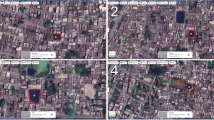Abstract
Spatial samples of surface and ground water collected from land disposal site of dye waste mixed sewage effluents at Binjhole, in Haryana, India were analyzed to evaluate its effect on quality of pond, hand pumps and ground waters for human health and irrigation purposes. It was found that average COD and TDS of dye houses discharge (310 and 3,920 mg/L) and treated sewage (428 and 1,470 mg/L) on mixing acquired the values of 245 and 1,780 mg/L and only Pb (0.24 μg/L) was above the permissible limit for irrigation purpose. Disposal of this mixed water to village pond changes the COD and TDS to 428 and 1,470 mg/L, respectively. COD and TDS of hand pump water samples were 264 and 1,190 mg/L, where as in tube well water these values were 151 and 900 mg/L. Though the ground water contamination seemed to decrease with the increasing distance from the pond but COD, TDS and BOD values continued to be quite high in water samples drawn from the hand pumps up to a distance of 500 m from pond. However, the major cause of the concern in these waters was Pb (0.11–0.45 ppm). Crops grown with this water shows accumulation of heavy metals like Pb,Cd, Fe, Mn, Ni, Cu, and Zn but in few crops they (Zn, Pb and Cd) exceed the safe limits. Regular consumption of these crop products may lead heavy metal toxicity. It was concluded from this study that the deep seepage of effluents led to deterioration of ground water quality for drinking purposes and the well waters rendered unfit for irrigation purposes within a span of 2 years. This warrants appropriate disposal measures for sewage and dye industry effluents in order to prevent deterioration of ground water and health of human and animals.



Similar content being viewed by others
References
APHA-AWWA-WPCE (1995) Standard methods for the examination of water and waste water. Franson Marry Ann H (ed) APHA, 1015, 15th Street, New Washington, DC 20005
Cirini G (2006) Non conventional low cost absorbents for dye removal: a review. J Bioresour Technol 97:1061–1085
FAO (1985) Water quality for agriculture. FAO Irrigation and Drainage Paper No. 29
FAO/RNE (1993) Monitoring waste water for irrigation. Tech Bull 7:18
Govt. of India (1999) Economic survey. Planing Commission, New Delhi
Khandelwal S (1996) Impact of dyeing industries waste water on vegetation of Luni catchment area. J Environ Pollu 3(2):77
Minhas PS, Gupta RK (1992) Quality of irrigation water-assessment and management. Information and publication section. Indian Council of Agriculture Research, New Delhi
Minhas PS, Samra JS (2004) Waste water use in peri-urban agriculture: impacts and opportunities. Bulletin No.1/2004. Central Soil Salinity Institute, Karnal, p 78
Minhas PS, Yadav RK, Sharma N, Joshi PK (2006) Prevalence and control of pathogenic contamination in some sewage irrigated vegetable, forage and cereal grain crops. Bioresour Technol 97:1174–1178
Ofosu-asoedi K, Oteino DA, Omolo JO, Etegni L, Englande AJ Jr (1999) Sewage re-use for irrigation in Tai river town Kenya: its implications on public health. Water Sci Technol 39(10–11):343–346
Scott CA, Faruquin NI, Raschid-Sally L (2004) Waste water use in irrigated agriculture. CABI Publ, Oxfordshire, p 193
Srivastava PN, Aditya P (1991) Bio-accumulation of heavy metals by algae and wheat plant fed textile effluents. J Ind Pollut Contr 7(1):25
Swami D, Budhi D (2006) Removal of contamination from industrial waste water through various non-convention technologies: a review. Int J Environ Pollut 27:324–346
USSL (1954) Diagnostic and improvement of saline and alkali soils. USDA Hand Book 60
Acknowledgments
Authors are grateful to Indian Council of Agricultural Research, New Delhi for funding this research study through National Agricultural Technology Project “Use of urban and industrial effluent in agriculture” under Mission Mode. The authors are also grateful for the help and guidance rendered by Dr. N.K. Tyagi, Director, CSSRI, Karnal. Corresponding author is grateful to Dr. C. Viswanathan, for this critical comments and help during manuscript writing. Help rendered by Shri Madan Singh, Art Section, CSSRI, Karnal for art work is also gratefully acknowledged.
Author information
Authors and Affiliations
Corresponding author
Rights and permissions
About this article
Cite this article
Dubey, S.K., Yadav, R., Chaturvedi, R.K. et al. Contamination of Ground Water as a Consequence of Land Disposal of Dye Waste Mixed Sewage Effluents: A Case Study of Panipat District of Haryana, India. Bull Environ Contam Toxicol 85, 295–300 (2010). https://doi.org/10.1007/s00128-010-0073-2
Received:
Accepted:
Published:
Issue Date:
DOI: https://doi.org/10.1007/s00128-010-0073-2




